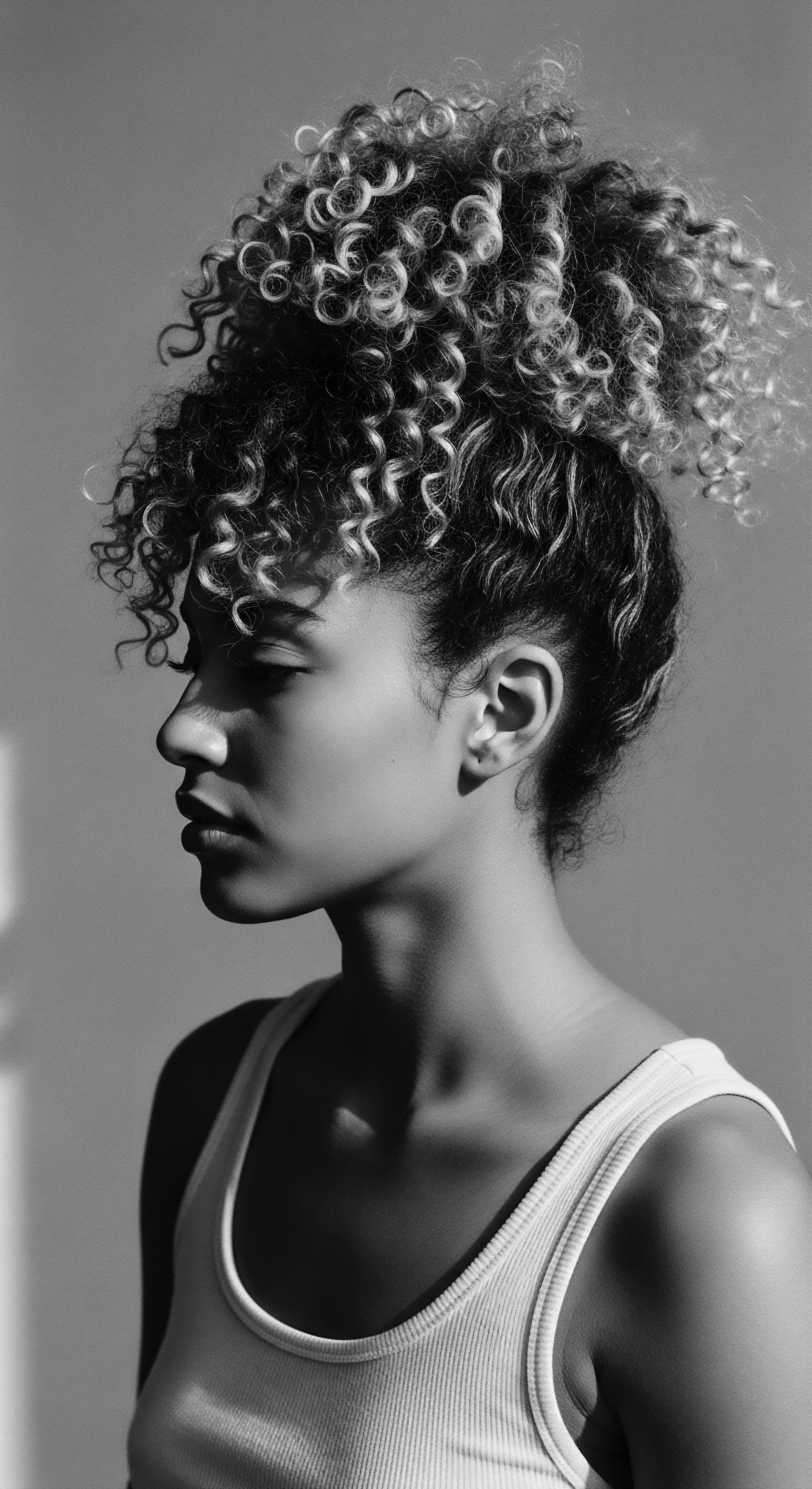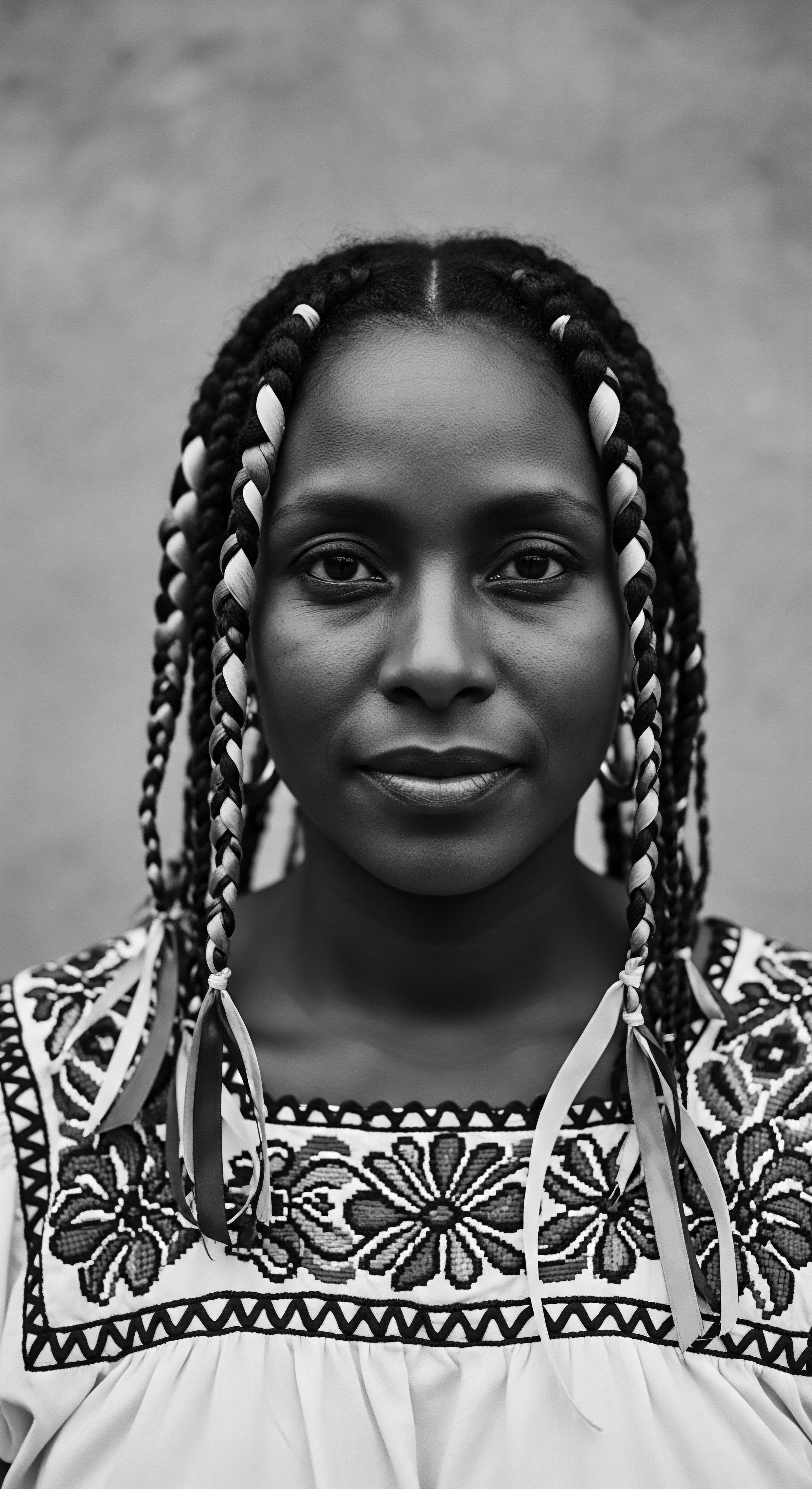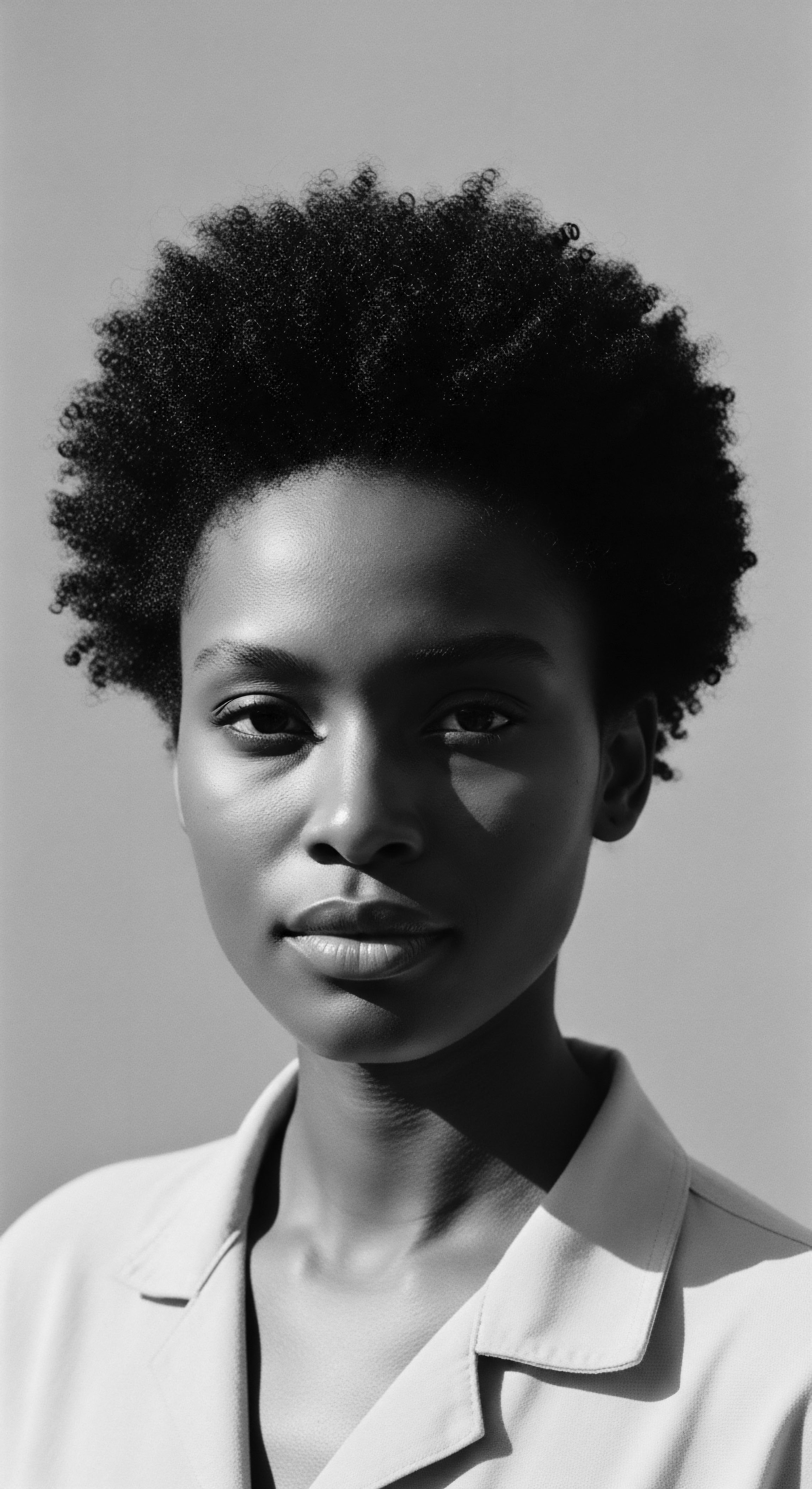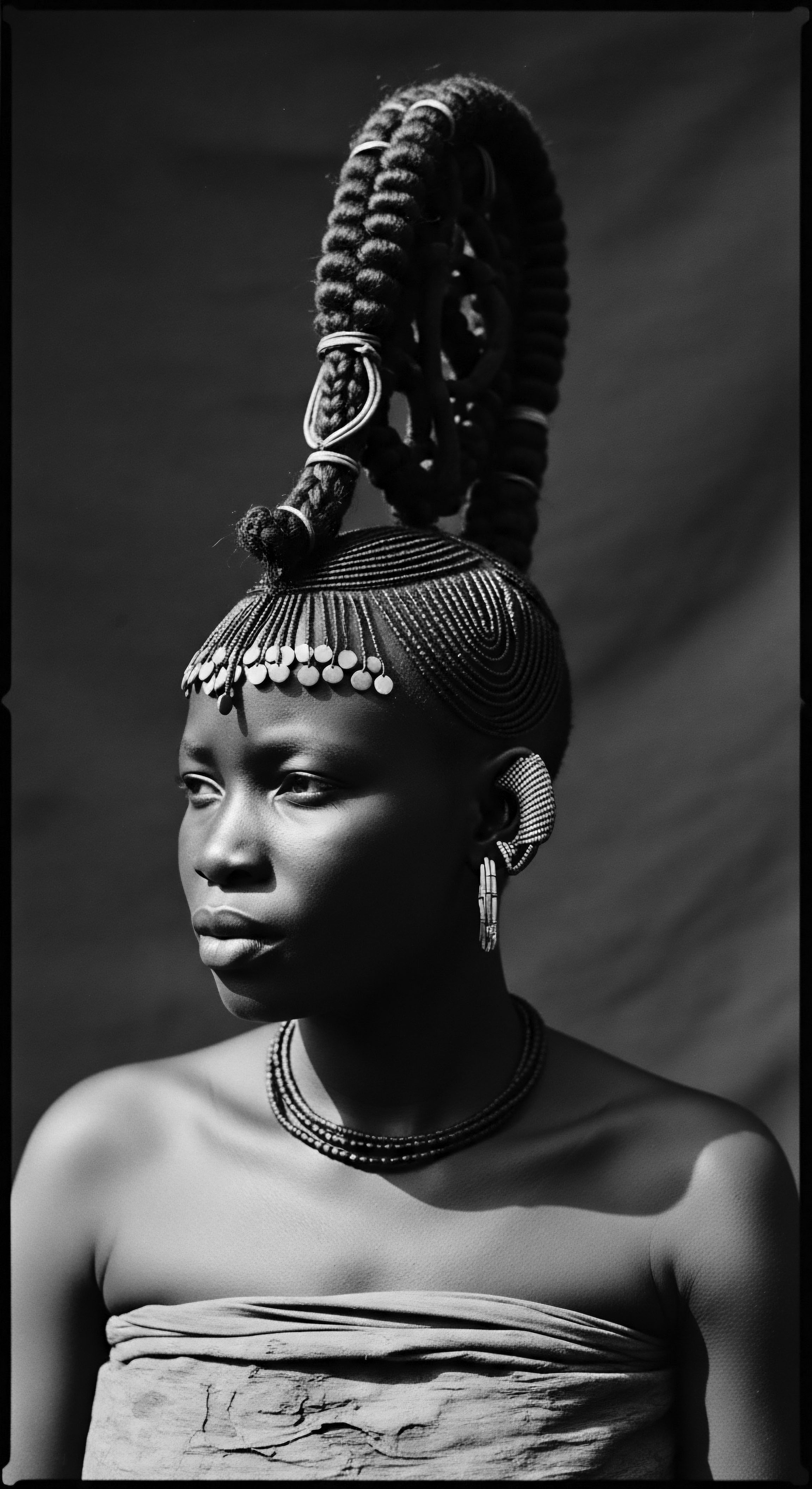
Roots
The stories whispered by strands of textured hair carry echoes of ancestral lands, of sun-drenched ceremonies, and of vibrant communities where hair was a living language. Each coil, every kink, and every resilient curl tells a tale of lineage, spirituality, and societal standing that stretched back thousands of years across the African continent. Hair was never merely an adornment; it was a profound aspect of being, a connection to the divine, and a canvas for communal identity. Then, across oceans and time, a stark reality emerged ❉ laws, enacted to diminish this very heritage.
Sumptuary laws, seemingly about dress, frequently coiled around Black women’s hair, attempting to sever this vital connection. Why did these decrees specifically target the crowns of Black women, seeking to obscure or control their textured hair heritage?
This inquiry calls for a deeper look, a recognition of the wisdom held within each fiber. It is a journey into the very structure of textured hair, the ancient practices that nurtured it, and the colonial forces that sought to suppress a heritage so deeply intertwined with identity. We are not just exploring historical edicts; we are examining the spirit of a people who, with every braid and every wrap, transformed instruments of subjugation into symbols of enduring pride.

The Biological Tapestry of Textured Hair
Understanding why sumptuary laws aimed to control Black women’s hair requires an appreciation for its elemental biology. Textured hair, particularly the tightly coiled and kinky varieties often found within Black and mixed-race communities, possesses a unique follicular structure. Unlike straight hair, which typically grows from a round follicle, coiled hair emerges from an elliptical or flat follicle. This shape leads to a strand that is not perfectly round but rather elliptical, creating a natural tendency for curls, kinks, and coils.
The hair shaft itself can have varying degrees of twists and turns, making it appear denser and often more voluminous. This unique helical structure, while visually striking and allowing for an astonishing range of styles, also influences how moisture travels along the strand and how the hair responds to external forces.
From an ancestral viewpoint, this hair was seen not as a challenge, but as a gift, inherently suited to the climates and lifestyles of African societies. Its density provided natural insulation, protecting the scalp from both intense sun and cooler temperatures. The natural coil patterns, often seen as a reflection of the spiraling patterns in nature and the cosmos, were celebrated as aspects of beauty and power. This deep connection to the natural world shaped care practices, focusing on communal grooming and the use of natural ingredients to nourish and maintain the hair’s vitality.

Ancient Origins of Hair Language
Long before the transatlantic journey, in pre-colonial African societies, hairstyles served as elaborate communication systems. A person’s hair conveyed specific information about their geographic origin, marital status, age, ethnic identity, religious beliefs, wealth, and social standing. For example, amongst the Yoruba people, hair held spiritual significance as the most elevated part of the body, and braided styles were even used to send messages to the gods.
The creation of these intricate styles could span hours, even days, involving careful washing, oiling, braiding, or twisting, often adorned with shells, beads, or cloth. Such meticulous care transformed hair grooming into a deeply social event, a precious time for bonding among family and friends—a tradition that persists in many communities today.
This complex visual language of hair was deeply embedded in daily life, informing interactions and reaffirming community bonds. Hairstyles were not static; they changed with life events, ceremonies, and even seasonal shifts, reflecting a dynamic relationship with one’s identity and environment. It was a heritage of self-expression, artistry, and communal cohesion, all physically manifested in the styling and adornment of textured hair. This deep cultural grammar, expressed through hair, stood in stark contrast to the simplistic, often derogatory, perceptions imposed by colonizers.
Hair was never merely an adornment; it was a profound aspect of being, a connection to the divine, and a canvas for communal identity.

The Imposition of a Colonial Gaze
The arrival of colonizers and the institution of the transatlantic slave trade marked a violent rupture in this rich heritage. Enslaved Africans suffered the systematic stripping of their identities, cultures, and personal belongings. Hair, this cherished symbol of identity and spiritual connection, became an early target.
Slave traders often shaved the heads of captured Africans upon arrival, a deliberate act of dehumanization intended to erase their cultural ties and sever their profound connection to homeland and lineage. This initial act set a brutal precedent for the policing of Black hair in the Americas.
As enslaved people and later free Black communities navigated new and oppressive landscapes, they often lacked the traditional tools, ingredients, and communal time for hair care. Yet, ingenuity persisted. They utilized whatever was available—bacon grease, butter, kerosene as conditioners, cornmeal as dry shampoo, or even sheep fleece carding tools as combs.
Despite attempts to suppress and devalue their hair, they found ways to protect and style it, sometimes even braiding rice seeds into their hair as a means of survival or using cornrows to map escape routes. The sheer creativity and resilience demonstrated in maintaining hair care practices, even under duress, speaks volumes about the enduring significance of textured hair heritage.
Sumptuary laws, particularly in the colonial context, were not novel. They had existed in European societies for centuries, often regulating consumption and delineating social rank. However, their application in the Americas, specifically targeting Black women, gained a different, more sinister dimension. These laws became instruments of racial and class profiling, designed to enforce a strict racial hierarchy and undermine the growing social and economic mobility of free Black communities.
The vibrant, ornate hairstyles of free Black women in places like New Orleans, which mirrored the elegance of European styles but with an unmistakable African-derived flair, were perceived as a direct challenge to the white social order. Their beauty, and the attention it garnered from white men, sparked alarm among white women, who saw them as competitors for status. This perceived threat led to legislative action, seeking to diminish their visibility and relegate them to a subordinate social position.
- Yoruba Hair ❉ Hair was considered the body’s highest point, a conduit for spiritual messages.
- Hair as Identity ❉ Styles denoted marital status, age, wealth, and tribal affiliation in pre-colonial Africa.
- Head Shaving ❉ A dehumanizing tactic used by slave traders to erase cultural ties.

Ritual
The deliberate acts of styling textured hair in Black communities have always been more than simple grooming; they are rituals. They are expressions of cultural memory, acts of communal bonding, and assertions of selfhood in a world often hostile to their very existence. This rich heritage of hair ritual, born of ancient practices and adapted through survival, found itself directly confronting sumptuary laws designed to strip away its very meaning. These laws sought to dismantle a living art form, a science of adornment, and a profound declaration of identity.

Protective Styles as Cultural Armor
Protective styles, such as braids, twists, and locs, have been central to Black hair heritage for millennia. These styles, some dating back as far as 3000 B.C. in regions of Africa, were not merely aesthetic choices. They served a practical purpose ❉ safeguarding the hair from environmental damage, retaining moisture, and minimizing breakage.
Beyond practicality, they functioned as cultural armor, preserving tradition and identity even amidst immense pressures. This knowledge, passed down through generations, represents an unbroken chain of ancestral wisdom regarding hair health and longevity. The act of braiding, for instance, became a rite of passage, often performed in shared spaces, solidifying family and community bonds.
The collective ingenuity in maintaining these styles, often with limited resources during enslavement, underscores their significance. Enslaved women found ways to continue these protective practices, utilizing whatever was at hand, demonstrating a fierce will to maintain their cultural legacy. This persistence, in the face of forced assimilation, turned styling into an act of quiet, persistent rebellion.

Adornment and Communication Through Hair Artistry
Across ancient African societies, hair was a medium for artistry and communication. Elaborate patterns and specific adornments communicated a wealth of information about an individual’s standing and cultural affiliations. Royal figures wore ornate beaded braids, while new mothers might don special headdresses.
These styles were complex and took considerable time to create, transforming the process into a social ritual, a time for sharing stories and strengthening relationships. This heritage of intricate hair artistry, a visual language of belonging and status, became a direct target for colonial authorities.
The very beauty and expressiveness of these styles were deemed threatening. Colonial powers, anxious about maintaining strict racial hierarchies and preventing social mobility among free Black populations, perceived the visibility and elegance of Black women’s hair as a challenge. These adornments, the beads, the feathers, the vibrant fabrics that accented their natural hair or protective styles, were seen not as cultural expression but as “excessive attention to dress,” a luxury incompatible with their assigned “condition and origin.”

When Did Colonial Statutes Seek to Suppress Cultural Expression?
The Tignon Law, enacted in 1786 by Spanish Governor Esteban Rodríguez Miró in Louisiana, serves as a poignant historical example of sumptuary laws directly targeting Black women’s hair heritage. This law specifically aimed to prohibit “creole women of color from displaying excessive attention to dress in the streets of New Orleans.” The decree mandated that free Black women, along with enslaved women, wear a tignon—a headscarf or kerchief—to cover their hair, explicitly stating they could “no longer have feathers nor jewelry in their hair.” Miró’s intent was unambiguous ❉ to visually mark free Black women as belonging to the enslaved class, thus cementing a racial distinction and limiting their social influence. It sought to diminish their appeal to white men, which was perceived to threaten the social order.
Sumptuary laws, particularly in the colonial context, were instruments of racial and class profiling, designed to enforce a strict racial hierarchy and undermine the growing social and economic mobility of free Black communities.
However, the women who were targets of this law, rich with a heritage of creative resistance, responded with remarkable ingenuity. They complied with the letter of the law but subverted its spirit. Free Black women began to wear tignons crafted from luxurious fabrics—silks, satins, and vibrant textiles—and tied them in elaborate, artistic knots. They adorned these mandated head coverings with jewels, ribbons, and feathers, transforming a symbol of subjugation into a statement of defiance, beauty, and wealth.
This act of creative re-articulation effectively turned the tignon into a “mark of distinction,” a powerful emblem of their continued self-expression and cultural pride. This defiance demonstrates a profound understanding of sartorial insurgency, pushing back against legislative control through aesthetic means. (Willson, 2018, p. 12) The tignon, therefore, stands as a testament to the resilient spirit and artistic adaptability inherent in Black women’s hair heritage, proving that true expression can seldom be legislated into silence.
This phenomenon was not isolated to Louisiana; sumptuary laws targeting dress and adornment, including hair, were also present in other Caribbean colonies. For instance, a 1779 regulation in Haiti prohibited “gens de couleur” (people of color) from “assimilating” white fashions or wearing luxury goods “incompatible with the simplicity of their condition and origin.” These laws, varying by region, shared a common purpose ❉ to segregate and subjugate people of color and to discourage interracial relationships.
| Aspect of Hair Styling |
| Ancestral Significance Communication of status, age, identity, spirituality. |
| Colonial Sumptuary Law Intent To strip identity, enforce racial hierarchy, symbolize subjugation. |
| Aspect of Hair Adornment |
| Ancestral Significance Expression of wealth, beauty, and cultural affiliation. |
| Colonial Sumptuary Law Intent To prohibit "luxury" and diminish perceived attractiveness. |
| Aspect of Hair Communal Ritual |
| Ancestral Significance Bonding, knowledge transfer, social cohesion. |
| Colonial Sumptuary Law Intent To isolate, disrupt cultural practices, and control social gatherings. |
| Aspect of Hair The profound chasm between hair's intrinsic heritage and its colonial suppression highlights a relentless struggle for autonomy. |

Relay
The journey of textured hair through history is a testament to the profound resilience of Black and mixed-race communities. The very act of caring for one’s hair became a form of survival, a silent yet potent act of resistance against systems that sought to diminish or erase their cultural legacy. Sumptuary laws aimed to control outward appearance, but they inevitably clashed with deep-seated ancestral wisdom, prompting continuous acts of adaptation and reclamation. The story of why sumptuary laws targeted Black women’s hair heritage extends into how these communities maintained well-being and problem-solving through traditional practices, asserting identity despite external pressures.

Ancestral Regimens for Hair Well-Being
Long before the advent of modern hair products, African ancestral practices provided sophisticated regimens for hair well-being. These practices were rooted in a deep understanding of natural elements and their beneficial properties. Ingredients native to African lands, such as shea butter, argan oil, and various plant extracts, were staples in maintaining hair moisture, strength, and overall scalp health.
These natural oils and creams were used to protect hair from harsh conditions and retain moisture, even during periods of enslavement when access to traditional resources was severely limited. The meticulous process of washing, oiling, and detangling was often a communal activity, passed down through generations, embodying collective knowledge and care.
This holistic approach recognized the interconnectedness of hair health with overall physical and spiritual well-being. It was understood that vibrant hair reflected a balanced inner state and connection to one’s lineage. The continued use of these traditional methods, even after forced migration, served as a powerful link to a heritage that colonial powers sought to dismantle.

The Battle for Self-Perception
The impact of sumptuary laws on Black women’s hair extended far beyond mere aesthetics; it deeply affected self-perception and mental well-being. By attempting to mandate covering or altering natural hair, these laws implied that textured hair, in its unadorned state, was undesirable, uncivilized, or a threat to social order. This contributed to the insidious development of Eurocentric beauty standards that deemed Black hair as “unprofessional” or “messy.” Such messages, whether explicit in laws or subtle in societal expectations, created a profound psychological burden.
The mental health consequences of hair-based stigma include internalized racism, negative self-image, anxiety about how others perceive one’s hair, and chronic stress, particularly in professional or academic settings. Many Black women historically felt, and sometimes still feel, pressure to chemically straighten their hair to conform and avoid discrimination. This process, while offering a semblance of societal acceptance, often came at a physical cost, causing damage to the hair and scalp, and a psychological cost, requiring individuals to suppress a part of their authentic self. The ongoing “policing” of Black women’s appearances, historically through laws and presently through societal norms, means that choices about hair are often loaded with implications beyond personal style, touching on cultural identity, ancestral pride, and the struggle against assimilation.

To What Extent Did These Decrees Reshape Communal Hair Practices?
Sumptuary laws, like the Tignon Law, did not entirely erase ancestral hair practices, but they undeniably reshaped their public expression and, in some ways, intensified their significance as acts of cultural preservation. The direct mandate to cover hair, intended to diminish and control, inadvertently transformed the headwrap into a powerful symbol of resistance and a canvas for artistic defiance. Rather than abandoning their practices, Black women adapted, pouring their creative energy and cultural pride into the very head coverings designed to suppress them.
This adaptation fostered new forms of communal exchange around head wrapping, becoming an art form in itself. The shared knowledge of how to tie and adorn a tignon, making it an expression of individual and collective beauty, reinforced community ties. What began as a tool of oppression was re-appropriated as a symbol of identity and resilience.
The journey of textured hair through history is a testament to the profound resilience of Black and mixed-race communities.
The emphasis on protective styles and head coverings also shifted, in some contexts, from an ancient tradition to a necessity for survival under colonial rule. While the underlying practices of care remained, the public display of hair became fraught with political meaning. This historical context illuminates why discussions of Black hair continue to be connected to broader conversations about autonomy, systemic racism, and cultural identity. The legacy of these laws is still felt, as contemporary movements like the CROWN Act seek to legally protect the right to wear natural hairstyles in schools and workplaces, confronting the lingering biases rooted in historical attempts to control Black appearance.
- Shea Butter ❉ A traditional African emollient used for moisturizing hair and scalp.
- Cornrows as Maps ❉ Enslaved people strategically braided cornrows to share escape routes.
- Headwrap Transformation ❉ A mandated covering turned into an elaborate statement of resistance and beauty.

Science Affirming Heritage Care
Modern trichology and dermatological research increasingly validate the efficacy of traditional hair care practices, revealing the scientific basis for ancestral wisdom. For instance, the use of natural oils, widely practiced in African hair care, is now recognized for its benefits in sealing moisture into the hair shaft, reducing breakage, and nourishing the scalp. The very structure of coiled hair, which makes it prone to dryness due to the difficulty of natural oils traveling down the spiral, benefits significantly from these external applications.
The concept of protective styling, deeply rooted in heritage, finds scientific support in its ability to minimize manipulation and exposure to environmental stressors, thereby promoting length retention and reducing damage. This scientific validation helps to dismantle long-held biases that dismissed traditional Black hair care as unrefined or primitive. It underscores that what colonizers perceived as “wild” or “unruly” hair, and thus sought to control, was simply hair requiring a different, culturally attuned approach to care—an approach often steeped in generations of empirical knowledge. This convergence of ancient practice and contemporary understanding empowers individuals to honor their hair heritage with renewed appreciation and confidence.

Reflection
The echoes of sumptuary laws targeting Black women’s hair heritage still ripple through contemporary society, yet they speak not of defeat, but of an enduring spirit, a magnificent refusal to be culturally silenced. Each strand of textured hair, whether styled in defiant coils or wrapped in vibrant fabrics, carries the weight of history and the light of perseverance. The narrative of control versus creativity, suppression versus expression, tells a profound story of identity’s deep roots. We witness how, through generations, the very acts intended to diminish became catalysts for deeper connection to heritage, for stronger community bonds, and for an artistic ingenuity that transformed oppression into artistry.
The “Soul of a Strand” is truly a living archive, breathing with ancestral wisdom, scientific understanding, and a resilient beauty that transcends time. It is a constant reminder that hair, for Black women, is never merely a physical attribute. It is a legacy, a political statement, a spiritual connection, and a testament to an unbreakable cultural lineage. To understand why such laws existed is to grasp the depth of fear and control that power structures sought to wield over the Black body and spirit.
To witness the response – the turning of constraint into couture, the quiet, persistent care for hair despite immense pressure – is to witness the triumph of heritage. This understanding compels us to not only acknowledge the past but to celebrate the ongoing journey of self-acceptance and affirmation that textured hair continues to represent.

References
- Byrd, Ayana D. and Lori L. Tharps. Hair Story ❉ Untangling the Roots of Black Hair in America. St. Martin’s Press, 2001.
- Dabiri, Emma. Twisted ❉ The Tangled History of Black Hair Culture. Harper Perennial, 2020.
- Gould, Virginia M. The Devil’s Lane ❉ Sex and Race in the Early South. Oxford University Press, 1996.
- Mbilishaka, Afiya M. “Don’t Get It Twisted ❉ Untangling the Psychology of Hair Discrimination Within Black Communities.” American Journal of Orthopsychiatry, vol. 90, no. 6, 2020, pp. 627-630.
- Patton, Tracy Owens. African-American Hair as a Social and Cultural Barometer ❉ The Politics of Hair, Identity, and Race. University Press of Mississippi, 2006.
- Robson, Helen. Clothing the Black Body in Slavery ❉ What They Wore and How it Was Made. CUNY Academic Works, 2021.
- Tharps, Lori L. “Tangled Roots ❉ Decoding the History of Black Hair.” CBC Radio, 2021.
- Willson, Nicole. “Sartorial insurgencies ❉ Rebel women, headwraps and the revolutionary Black Atlantic.” Journal of Transatlantic Studies, vol. 16, no. 1, 2018, pp. 10-25.
